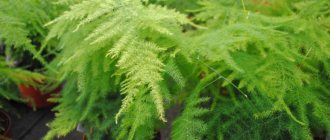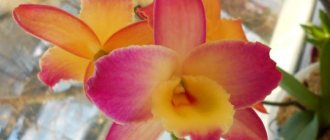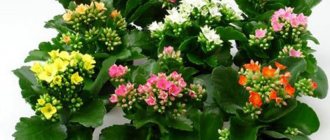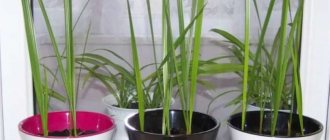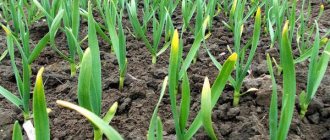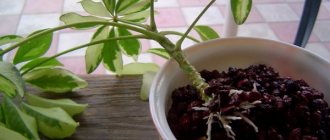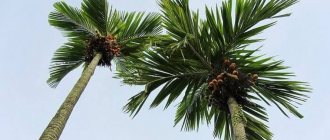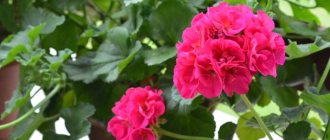Date palm diseases: yellowing and drying of leaves
Exotic plants are increasingly found in the homes of domestic citizens.
A special place among such unusual decorative “green oases” is occupied by the slender and presentable date palm. However, its diseases (for example, yellowing and drying of leaves), which occur with improper care, can frustrate inexperienced gardeners. To get the desired result when landscaping your apartment, you first need to choose the right type of decorative palm tree.
Since not every tropical beauty can take root at home, experienced experts recommend giving preference to the following varieties:
- robelena - a home flower up to 2 m high with attractive succulent leaves;
- Canarian species - a plant with narrow and fairly rigid leaves, which reaches 1.5-2 m;
- palmate is the most popular variety due to its unpretentiousness and rapid growth, but in appearance it is inferior to its “relatives”.
By choosing just such species, you can avoid difficulties without significant effort and prevent situations where the graceful leaves of the date palm dry out.
When a palm tree turns into a pet zoo
Each plant needs special attention. For this reason, it is important to monitor your greenhouse closely every day. As a result, the florist will be able to notice the malicious pests of indoor palm trees in time. Often, parasitic insects differ in external characteristics. However, the harm they cause is almost the same.
Scale insect and false scale insect
If small tubercles/droplets (from 2 to 5 mm) of a brown hue appear on the leaves, it means that the scale insect has come to visit. Its diet is fresh plant juice. Because of this, the leaf area underneath them often becomes pale. If you remove them with your fingernail and crush them, thick yellow mucus will flow out from inside. Among other things, insects secrete a sticky coating in the form of white dots on the palm tree. Unfortunately, they can also appear on neighboring plants.
It is impossible to destroy the parasite with an insecticide, because it is protected by a dense shell. Therefore, it is better to use intestinal drugs. Ingestion of poisoned foliage leads to paralysis, and the scale insect eventually dies.
Some gardeners recommend treating the crop with an alcohol solution or water-oil emulsions. At the same time, you can replace the top layer of soil in the pot. Whether this will help or not largely depends on what stage of infection the flowerpot is at.
Mealybug
These insects are close relatives of the scale insect. Their diet is the same - the juice of the crop. They differ only in their oval shape (3-5 mm) and light color. The white larvae that appear on the palm tree quickly increase in number and begin to settle in:
When using sprays, you must follow the instructions. If you bring the sprayer too close, the concentrated product can damage the leaf blades.
Parasites secrete a waxy sticky mass. Due to their active life activity, palm growth slows down. As a treatment you should try:
- regularly collect larvae;
- remove severely affected leaves;
- every 7 days, wash the greens with a soap or alcohol solution (often mixed with onion or garlic juice);
- use lepodocides - preparations of biological origin with toxic substances;
- use systemic insecticides that are absorbed by the crop and poison all the tissues of the flower (the bugs eat them and then die).
Preparations with biologically active substances are applied only to infected areas, which are the habitat of the colony.
It is impossible to single out any universal drug or method of control. Often you have to experiment and apply several methods in turn. Nevertheless, experience shows that palm diseases can be successfully combated at home. It is only important to diagnose them correctly.
Read also: What vitamins is lemon rich in?
Fighting yellowing of leaves - video
Indoor palm trees perfectly complement the interior of any room. They bring a touch of exoticism, lightness, and fill the room with freshness and joy. However, unfortunately, these plants often get sick.
The article discusses the most common diseases and pests of palm trees, as well as ways to combat them. If you follow the basic rules of care and take timely measures to combat illnesses, you can ensure long-term healthy growth and the mesmerizing greenery of an exotic beauty.
Reasons why date palm leaves turn yellow and dry
Date palm wilting occurs for two reasons: improper care and insect pests.
By eliminating these unfavorable factors, you can combat the consequences: softened trunk, dry tips of leaves, yellow coloring of branches.
In order to deal with the diseases of this ornamental plant, it is worth linking them with previous causes:
- excess moisture or the use of low temperature water can lead to the appearance of dark spots on the foliage of the flower. Establishing sufficient drainage will eliminate this problem;
- the leaves of the date palm begin to turn yellow and dry out due to insufficient watering or the use of hard water;
- a soft rotting trunk of a plant may be the result of excess moisture in the soil. In this case, you should carefully examine its root system, clean it of dead roots and replant it in another pot with good drainage and fresh soil;
- dry air, drafts and cold temperatures may be the answer to the question why the tips of the leaves of the domestic date palm dry out and turn yellow. Using an air humidifier, regular spraying and creating a constant required temperature will help cope with these problems;
- Spider mites are the most common pest for domestic green “pets”. It starts in the spring in the stems of the plant, gradually enveloping it in a barely noticeable web;
- The scale insect is the main enemy for the exotic beauty, because, feeding on its juice, it slowly covers the leaves with small scales. Such an insect may also be the reason why date palm leaves turn yellow;
- thrips is a parasitic insect known to gardeners that damages the lower parts of the palm stem, which leads to rapid drying of not only the leaves, but the entire plant;
- Mealyworm - starts in young shoots, sucking their juice. The infected flower becomes covered with a white cobwebby coating and dies.
If home flower diseases arose as a result of illiterate care, then the treatment methods are quite clear - eliminating the causes of the disease and damage. However, if the answer to the question of why exotic date palm leaves dry and wither lies in the presence of insect pests, then the situation is more complicated. You can’t do without chemicals and “medicines.”
Experts recommend using fitoverm, phosphamide or pyrethrum. You should spray such chemicals no more than once a week in diluted form. As a preventive measure or treatment against parasites in the initial stages, you can use a soap solution to wash the leaves.
It is worth remembering that all your efforts and efforts will be rewarded. Your home beauty will delight the eye with her healthy and presentable appearance, decorating your home interior!
Conditions for the existence of a tropical plant at home
There are many varieties of palm trees, but not all of them are suitable for growing at home. Palm diseases arise due to the peculiarities of their care. Do not forget that the homeland for most of these trees is the tropics, because they are called tropical. Accordingly, for a tree to function normally, it is necessary to create conditions that are as close to natural as possible. First of all, adequate watering should be ensured. The tropics are not only hot, but also very humid. The plant by its nature requires a lot of water. Provide the palm tree with daily watering in the warm season; in the cold season, it can be reduced to 3-4 times a week. If you normalize the watering regime, the yellow and dry tips of the leaves will gradually return to normal.
The most common cause of yellowing palm leaves is lack of moisture.
Dry air is another factor that leads to plant leaves turning yellow. In the tropics, the air is never dry, so plants get used to high humidity, which is what they will require at home. To humidify the air, place a humidifier or hang a container of water in the room where the plant lives. After some time, the leaves should be saturated with moisture and turn green.
If these measures do not help, then most likely the tree requires a larger pot. It is worth knowing that it has a very branched root system and is not used to cramped conditions, so it will not put up with a small pot. The ideal solution is to transplant it into a spacious tub. If you think that a spacious home has already been allocated for the tree, then you should not touch it, but you can always feed the palm tree with specialized products from the store. Sometimes a tree begins to get sick because it simply does not have enough vitamins to maintain a full life. It is not allowed to replant the tree often, as it does not like it.
Like other indoor plants, palm trees can be susceptible to attack by various pests. Under their influence, it begins to wither, as a result the leaves turn yellow and dry out. Inspect the tree carefully; if you find any insects, treat the plant with store-bought insecticides.
If, despite all the measures taken, the yellowness still does not disappear from the leaves, you should pay attention to the place where the tree is located. The indoor palm tree does not like drafts; it prefers a warm, quiet place, but not near a central heating radiator. When the leaves of a palm tree dry, this means that the owner did not provide the tree with the freedom to which it is accustomed in its natural environment.
A previously lush, beautiful palm tree may begin to turn yellow and crumble. This is due to inappropriate growing conditions, incorrect or the presence of a pest. Let's take a closer look at why indoor palm leaves turn yellow and how to deal with the problem.
This reason is one of the main ones that lead to yellowing and drying of the leaves of the plant. The driest air is observed in mid-summer and winter, after turning on the central heating.
When trying to moisten a palm tree, you should never flood it - wet soil has nothing to do with humidity. This will lead to rotting of the roots and death of the plant.
The simplest and most effective way to moisten a plant is to spray it with a spray bottle.
The leaves of the plant will receive the necessary moisture and their cells will begin to work at full capacity, performing the process of photosynthesis. Other methods of humidifying indoor air include:
A hygrometer is used to determine the degree of humidity. The digital version will also show the air temperature and current time.
Why palm leaves dry out: main reasons
Although most indoor palms are true tropical plants, they do not tolerate heat well, especially if high temperatures are accompanied by low indoor humidity.
The risk of leaves drying out at the tips increases significantly during the heating season, when currents of hot air rise from the radiators.
In addition to these factors, a palm tree can dry leaves in the following situations:
- Temperature changes or exposure to drafts;
- Frequent transplants unnecessarily;
- Improper watering (severe drying out or waterlogging of the earthen clod);
- Mineral fasting;
- Impact of pests and consequences of diseases.
Keeping the palm tree in a suitable microclimate and normalizing care solves the problem of drying leaves.
Important: if you find dried leaves on a palm tree, do not panic - often the lower tier dies off on its own as the crown grows.
Low air humidity: what to do?
Dry air not only does not add beauty to a home palm tree, but also affects its health, reducing resistance to pests and diseases.
That is why the primary task is to normalize humidity, which can be achieved in several ways:
- Spray the leaves daily with a spray bottle. You need to use warm, settled water, dispersing it with a fine spray.
- Install special devices. An electric humidifier is an ideal solution during the heating season.
- Create natural hydration. Several pots with plants, bowls with expanded clay, filled with water, release moisture, maintaining an optimal microclimate.
Additionally, you can cover the batteries with a wet towel if the pot with a palm tree is on a windowsill or near a window.
Ventilate the room periodically if the outside temperature rises above zero. Bathing in a warm shower will also benefit the plant and improve the condition of the foliage.
Unsuitable temperature and drafts
Winter maintenance of a home palm tree should be given special attention, since it is during the cold months that the plant is at rest, accumulating strength for future active growth.
“Equatorial” indoor temperatures are the worst thing you can do to a palm tree during its resting period. The heat causes the leaves to dry out, the crop loses its attractive appearance and subsequently takes a long time to recover.
The temperature in the room must be maintained depending on the type:
- +8-+12 degrees – for Washingtonia, trachycarpus and brachea;
- about +24 – for the Robelena date, chamedorea and areca;
- +16 degrees – for rapis, rapalostilis and sabal.
Without ventilation, palm tree leaves dry out at the tips, and drafts harm the crown. Maintain a balance - take the pot out of the room when you open the window so that the green mass is not damaged by cold air flows.
Common causes of yellowing foliage
Sometimes palm leaves turn yellow and fall off for a natural reason - the plant gets rid of old lower leaves. But most often yellow leaves appear for other reasons.
Dry air
Owners of indoor plants are often perplexed as to why palm leaves dry out. Often in winter it becomes hot in apartments due to hot radiators. This atmosphere has a negative impact on green plants; for a palm tree, a suitable temperature in winter is considered to be between 15 and 20 degrees. Dry air must be humidified; the tropical plant should be sprayed with a spray bottle.
The top layer of soil should be moist; the palm tree should not be watered frequently.
Draft
The opinion that a palm tree can only be placed in the southern part of the room is incorrect. Direct sunlight has a detrimental effect on the plant; it is best to place the pot a little away from the window. In winter, a cold window sill harms the flower; at this time of year, most palm trees dry out and wither, their leaves turn yellow, blacken and fall off. Drafts are contraindicated for palm trees.
Frequent replanting
One of the answers to the question why the leaves of an indoor palm tree turn yellow is improper replanting. You need to place a palm tree in a new pot when it is cramped in the old pot, the roots have grown too much. Replanting a young plant should be done no more than once a year. In some cases, the top layer of soil can be replaced. An older flower is replanted approximately every three years. The new pot should be taller and wider than the previous one.
The date palm is drying up - what to do?
The main cause of disease, as a rule, is improper care. The plant can get sick due to non-compliance with heat, humidity and lighting. Why does the date palm dry out and what signs can be used to determine what is wrong with the tree?
- If you notice that the trunk of a palm tree has become soft and emits an unpleasant smell with a hint of putrefaction, while the leaves have changed their color and become dark, almost brown, then most likely you have overdone the watering.
What to do? Of course, the first thing to do is stop watering and dry out the soil. It is better to remove the palm tree from the pot and carefully examine the roots. If the roots have darkened, become watery and soft, you are probably too late, and you will no longer be able to save the plant. If not all roots have died, but there are still living ones, a separation operation must be performed. Cut off all bad roots and sprinkle the “wounds” with charcoal powder.
For health and freshness
How to rejuvenate a date palm? Renewal of the date palm consists of constant renewal of leaves that appear from above and die from below. It is necessary to remove fading or dried lower branches .
The top branches cannot be cut ! This can lead to the death of the plant. Drying of the upper branch is an unnatural process and signals a disease.
To give the plant freshness, the leaves need to be sprayed daily . Once a week, you can abundantly water the above-ground part of the plant, while covering the ground with film. It’s a good idea to wipe the leaves with a damp sponge; this will give the plant freshness and serve as additional prevention against parasites.
How to provide the date palm with proper care?
When growing a plant indoors, you need to provide it with the most acceptable care. If lighting is easier in this sense, then watering can be difficult to guess, because we don’t see what’s happening inside the pot, and piercing the soil in the pot is dangerous - you can damage the roots. You can check soil moisture in the following way. Tap the pot from top to bottom with your knuckles. A hollow sound means the soil is dry, a dull sound means the soil is wet.
If the soil composition is correct, you can water the pot until water flows into the pan. The water that spilled there should be removed after 2-3 hours, if it remains there. Water the palm tree, like most indoor plants, with settled water at room temperature.
Growing conditions
Inside the date palm fruit there is a large and hard oblong stone. It remains viable for a very long time. Even dried date seeds can be used as seed material.
When propagating dates from seeds, one cannot talk about preserving the varietal characteristics of the plant.
The ideal and affordable seed material is the pits of dried or sun-dried dates.
Preparing date pits for planting
Date pits that have not undergone heat treatment are suitable for germination. You can simply stick them into the ground, in most cases shoots appear, but sometimes you have to wait 5-6 months. You can speed up this process as follows:
- The pit is cleared of pulp, thoroughly washed and dried.
- The next stage is preparation for soaking. To help water penetrate inside the seed faster, you can scratch it with sandpaper, scald it with boiling water, or make cuts.
- Soaking is carried out in any material that retains moisture well: cotton wool, gauze, sawdust. The container in which the seed is located must be provided with a high temperature by placing it, for example, on heating radiators. It is necessary to constantly monitor the moisture content of the material and the condition of the bone. As soon as it swells, it is transplanted into the ground.
The optimal time for seed germination to begin is February-March.
Even if you plan to grow only one palm tree, take several seeds for germination. This will insure you against the death of seedlings due to disease or unsuccessful experiments when replanting the plant.
Soil for date palm
For planting seeds, universal flower soil or a ready-made soil mixture for palm trees, which are sold in specialized stores, are suitable.
Soil for palm trees is produced on the basis of middle peat and vermicompost with the addition of sapropel, sand and vermiculite
You can prepare the soil mixture yourself. The optimal composition will be:
- light loam (2 parts);
- leaf compost (2 parts);
- peat (1 part);
- rotted mullein (1 part);
- sand (1 part);
- some charcoal.
At the bottom of the planting container you need to place a layer of drainage made of expanded clay or river pebbles. It will prevent stagnation of water, which is harmful to the roots of the plant.
Date planting
Planting a date pit is a simple process and consists of the following steps:
- Select a landing container. It may not be very wide, but it should have sufficient depth, since the date has long roots.
- Pre-prepared seeds are placed vertically in the soil mixture, sprinkled with a 1–1.5 cm layer of soil.
Planting material is embedded in prepared and pre-moistened soil to a depth equal to approximately the length of the seed.
The seed should be additionally sprinkled with soil and watered, while avoiding overmoistening.
Initially, the first simple leaf appears
To maintain humidity and retain heat, the planting container can be covered with cling film, but it should be opened slightly for ventilation every day.
Planting is recommended in early spring. In this case, young shoots will be able to receive the maximum amount of heat and light, grow stronger and prepare for transplantation and a period of winter dormancy.
Recommended soil composition
Depending on the age of the plant, the composition of the soil also changes.
- For a young plant, the following composition is suitable: 2 parts light turf soil, 1 part humus, 0.5 parts leaf, 0.5 parts sand.
- For a date palm 5-10 years old, the following composition is suitable: 1 part each of turf soil, compost, humus and sand.
- At the age of over 10 years, the following composition will be optimal: 2 parts turf, 2 parts compost, 1 part humus, 1 part sand.
Dates in the natural environment
The natural distribution area of the date palm is the deserts of Asia and North Africa. The deep root system of these plants is capable of extracting water from great depths. In its natural environment, the palm tree has a height of up to 20 m and can bear fruit for about 100 years.
The date palm is also called the phoenix. Its name is consonant with the name of the legendary mythological bird, which was able to burn itself and then be reborn from the ashes.
Palm plantings today are an important means of combating desertification
The date palm is a sacred tree for peoples inhabiting desert areas. Its fruits are called the bread of the desert, as they are the most important food product for the local population. Dates have an oblong shape with a hard seed inside. Since ancient times, they were dried and taken with them on long journeys by Egyptian and Phoenician merchants. Dried dates contain a huge supply of nutrients; they can not spoil and retain their taste even in the most intense heat.
Related article: The benefits of house plants, why we need indoor flowers
It is believed that a person can live for several years eating only dates and water.
Date palm from seed
Not everyone knows that it’s easy to grow a date palm yourself from an ordinary date that we buy in a store, or rather, from the seeds left over from it. True, this will take time. Place the date pit in plain water for several days, changing it daily. To make sprouts appear faster, it is recommended to scald the seed before planting. Dates that have been lying around for a long time are unlikely to sprout quickly, but nothing depends on us here.
The seed is pushed vertically into the ground so that the soil covers it by 1 cm. The ideal temperature for germination is 25-30 o C. Usually shoots appear after 2-3 months, but at first the tree grows very modestly. And only after 5-7 years will your room be fully decorated by a beautiful representative of the palm family.
Sources:
https://www.udec.ru/derevo/finikovaya-palma-bolezni.php https://rastenia.info/finikovaya-palma/sohnut-listya-chto-delat.html https://grounde.ru/finikovaja- palma-sohnet-zhelteet.html
Ways to combat parasites
To rid your green pet of parasite attacks, there are several methods. As a primary treatment, you can soap the sponge and remove insects. However, such a procedure is not able to completely defeat the infection, so radical measures are used. The following preparations are used for spraying :
- phosphamide;
- fitoverm;
- actellik;
- pyrethrum.
The proportion of the chemical solution is 2 g per 1 liter. water. It is advisable to spray once a week.
Traditional disinfection is also suitable: wipe the infected areas with a cotton swab soaked in alcohol and spray the rest of the plant.
The date palm has been known to man for more than 2000 years. As early as the sixth century BC, it was grown in Mesopatamia and in the territory of modern Iran. No less popular are indoor species, which can be grown from seeds without much difficulty.
Caring for date seedlings
Most problems with date cultivation are related to improper care. Restoring the health and beautiful appearance of a plant can be difficult.
How to replant a date
The date palm does not like transplants. But it is impossible to do without them, because for a young plant you should choose a small planting container that matches the size of the root system. When planting in a large pot, it is difficult to prevent overwatering, and this leads to palm diseases. The plant quickly takes nutrients from the soil and depletes it. Roots fill the empty space. If you do not replant, the palm tree will stop growing.
Untransplanted date palms do not fluff well and grow with one narrow leaf for a long time.
The best time to replant a date palm is in April. This is the start of the plant's activity, so fresh soil and room for roots to grow will encourage rapid development of the date. For the first 4 years, the plant requires annual replanting, then it can be done once every 2-3 years.
When replanting a palm tree, the preferred method is transferring, in which the plant is removed from the old pot along with a lump of earth and transferred to another pot (it should be several centimeters wider than the previous one). After this, all voids are filled with new soil mixture.
Palm trees are handled carefully, taking care not to damage the sensitive roots of the plant.
In pots with mature plants, it is recommended to replace the top layer of soil twice a year.
Optimal lighting and temperature modes
It is preferable to place the palm tree in a well-lit place, but in the hottest times it is recommended to shade the plant for a short time to prevent sunburn.
To ensure that the date palm produces leaves evenly, it is periodically rotated, directing the apical part of the plant indoors.
The optimal temperature during the period of active growth (spring and summer months) is 20–25 o C. During the dormant period (autumn and winter months), the recommended temperature regime is 15–18 o C. At this time, the date palm will easily tolerate a short drop in temperature (up to 8 o C), it reacts much worse to drafts.
When placing the pot, keep in mind that the cold of a marble floor or window sill can negatively affect the sensitive root system of the palm tree. In this case, it is recommended to use a variety of stands that will not only protect the roots of the plant, but will also organically fit into the interior of the room.
Watering and fertilizing
In summer, the date palm should be watered often and quite abundantly. If the soil dries out completely, the leaves may droop and it is very difficult to restore their previous position. The plant will need garters and supports to avoid leaf injury and maintain an attractive appearance. In winter, palm trees are watered much less often - high humidity at low temperatures is detrimental to the plant.
For irrigation, it is recommended to use water at room temperature that does not contain chlorine. Palma does not like calcium-mineralized (hard) water. The leaves will have a well-groomed appearance if they are wiped weekly with a damp sponge. The plant responds well to spraying. In summer they are carried out daily, and a shower is recommended for the palm tree once a week. When spraying and showering procedures, the earthen ball must be reliably protected from excess moisture.
In spring and summer, the palm tree crown is sprayed daily with warm, settled water.
To fertilize dates, it is recommended to use special preparations for palm trees or deciduous ornamental plants. During the period of active growth, palm trees are fertilized every 2 weeks. In winter - 2 times less often. Fertilizers should be applied in liquid form to pre-watered soil.
Some useful tips
Flower growers give valuable advice that will help you grow a beautiful exotic plant in a few years:
- placing a date palm near central heating devices can cause the death of the plant;
- In summer, it is recommended to take the tub with a palm tree out onto the balcony or into the garden. Be sure to make sure that there are no drafts harmful to the plant in the new location;
- direct sunlight is beneficial for the normal growth and development of only an adult palm tree;
- a grown plant can tolerate short periods of complete drought;
- The lifespan of palm leaves is approximately 1 year. Then they turn yellow, dry out, and must be removed. Pruning is done with a sharp tool, leaving a few centimeters from the petiole;
- The date palm is a single-stemmed plant. If it loses its apical part, it will stop growing.
